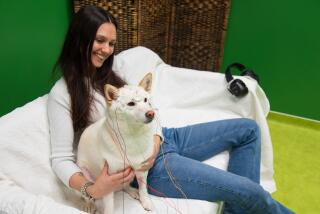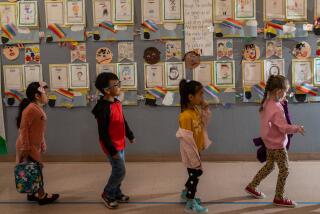Baby’s ‘Goo-Goo’ a Building Block of Human Speech
NEW YORK — Listening to a newborn’s plaintive squall, parents hear the hungry promise of a life to come.
In the babbling that precedes an infant’s first halting attempts to talk, however, scientists are discovering crucial clues to how children master the languages that connect humans to one another.
A remarkable picture of how infants learn to speak is emerging from clinical child studies, language surveys and brain imaging, all colored by the hard-won crib-and-nursery knowledge gathered by generations of parents.
The newest insight offers clear evidence that the brain has become specialized for language by the time an infant is 5 months old, according to a report published today in the journal Science. Dartmouth College scientists found the clue in the lopsided way an infant’s mouth opens and closes when he or she babbles or smiles.
Researchers Laura-Ann Petitto and Siobhan Holowka analyzed videotapes of 10 babbling babies from French-or English-speaking families. They collected 150 examples of facial expressions from each infant.
When the babies babbled, their mouths always opened more on the right side. When they made random cooing noises, their mouths always opened equally on both sides of the mouth. When they smiled, the mouth opened more on the left.
The expressions revealed the inner workings of the brain animating the baby’s face.
Each side of the face is controlled by a different half of the brain. The brain’s language-related machinery is on the left side of the brain, which controls the right side of the face. The distinctive right-side movement of the baby’s mouth when it babbled showed that the brain’s left hemisphere was in control, Petitto said.
“The findings were quite compelling,” Petitto said, because they show that the brain has organized itself around language years earlier than previously believed.
“Babbling is the first step on the road to learning a language,” she said.
Noam Chomsky, an influential language theorist at the Massachusetts Institute of Technology, called the finding “eminently sensible.” Cognitive scientist Steven Pinker at MIT said it was “quite ingenious.” And language development expert Paul Bloom at Yale University said the research demonstrates “there is something in the brain about language from the start that is special.”
Indeed, the research opens a window into the brain at the very moment when its cells and synapses are being transformed by the ability to speak its mind.
So important is human language that the communication centers of the brain are among the first neural structures to mature, the new research shows. The compulsion to communicate can spur dramatic rearrangements in the way a baby’s neural circuits function.
In a child’s fledgling efforts to talk, scientists can detect an echo of primitive language skills that humans share with a surprising range of other creatures, from crickets to chinchillas.
Babies and Tamarin monkeys, for example, share the ability to discriminate between random noise and human speech in different languages, even though neither can understand the words it hears, French and American researchers found.
But no other creature babbles.
In the gurgling nonsense of infant speech, shaped by the unique biomechanics of the human tongue, throat and jaw, some scientists are convinced they hear sounds of the first words that evolved when humanity itself was young.
No matter what the language, baby talk contains four distinct, universal patterns of vowels and consonants--ma-ma, da-da, ba-ba, goo-goo--that may have been the original building blocks of speech, University of Texas researchers contend.
Language experts like Chomsky and Pinker at MIT hold that the human brain is specialized for fundamental aspects of language, with every child inheriting the innate structure of a universal grammar in the same way that a spider inherits the pattern of the web it weaves.
Elizabeth Bates at UC San Diego and other language anatomy experts argue that an infant’s brain--perhaps the world’s most powerful learning device--is quite capable of deducing the nature and structure of its native language from the conversations around it.
“I believe we have underestimated what babies bring to the world in terms of being able to learn,” said neuroscientist Mark S. Seidenberg of the University of Wisconsin at Madison. “We underestimate the information that parents provide about language.”
On average, an infant will hear 16,000 examples of his or her parents’ speech in the first few months of life.
Every infant uses the networks of his or her brain to analyze the sounds and patterns in adult speech, research at New York University and the University of Wisconsin shows.
The exaggerated musical singsong of parental patter helps infants absorb crucial vowel sounds and other phonetic elements.
To sort the sense of words and grammar from nonsense, an infant’s brain uses surprisingly sophisticated statistical computations. They can quickly deduce rules and patterns about words and sentence structure, well before they know what the words mean or even how to say them.
In another study published today, Italian researchers showed how all human minds use that capability to crack the code of speech. Scientists led by Jacques Mehler at the International School for Advanced Studies in Trieste, Italy, reported that people use powerful statistical thinking to decipher a new language.
To better understand how the mind discovers language, Mehler made one up and then studied adults trying to learn it.
Neural number-crunching may be enough to find words, but grammar is so complicated that the brain must resort to a different mode of thinking to sort out sentence structure, they contended. The brain can easily switch between the two modes in thousandths of a second.
“This study supports the idea of the mind as a Swiss Army knife filled with different tools for different tasks,” said NYU psychologist Gary Marcus. “People can switch mental tools based on subtle cues, right on a dime.”
Scientists already have established that while the growing infant listens and babbles, his brain is building trillions of connections between its cells into the special neural circuits of language, whether the words are spoken aloud or signed with gestures.
Two-month-old babies can remember word sounds and the variations of speech.
At six months, infants begin to pair sounds with a specific meaning. About the same time, infants are tuned to the distinctive sounds of their native tongue.
By 7 months, they can deduce where sentences appear or words start and stop. And infants start memorizing words they hear long before they have any idea what they might mean.
An average year-old infant may understand 50 words. That number can triple in a month or two. By 24 months, children can recognize a word in their vocabulary within 600 milliseconds. By high school, the average young person may know 60,000 words, picking them up at the rate of about 10 new words a day.
It makes learning a language look like child’s play.






